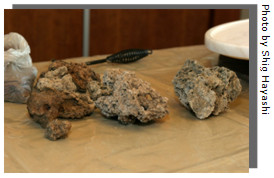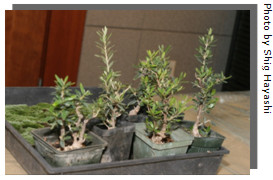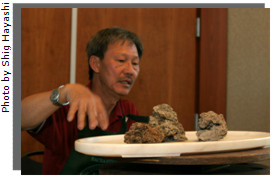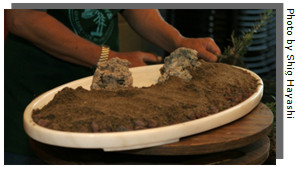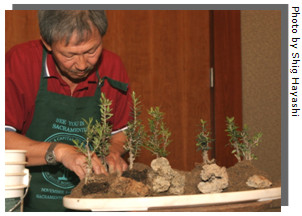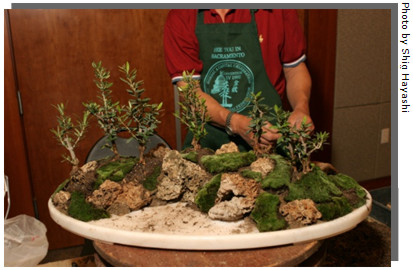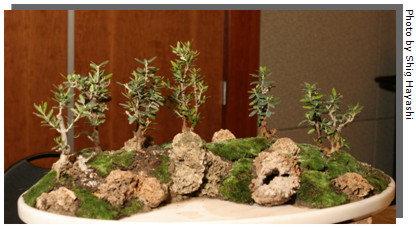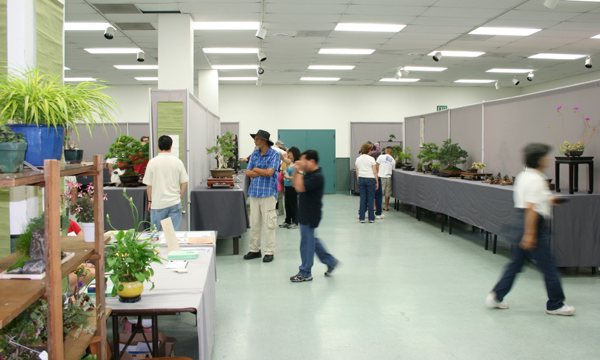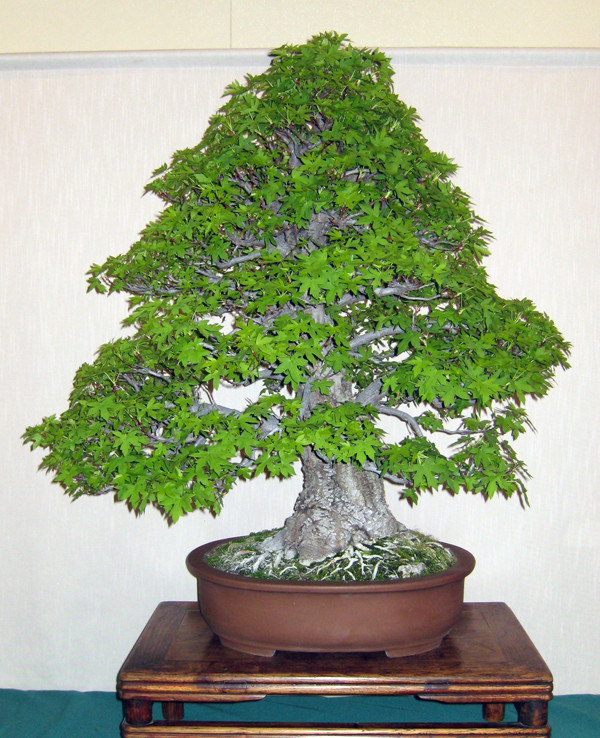June 2008 Newsletter
Perk Up Your Collection for Summer
By Ken Fuentes
Kick up your enthusiasm by adding new trees to your collection. I have found that the best way to increase your enthusiasm in any interest is to add something new. Because your trees are growing more, there is more maintenance required, and any ex-tra enthusiasm can go a long way.
|
This year’s mild June weather is a perfect time to add material to your collection. New members can get information on recommend bonsai nurseries with the best material and prices—and those that are geographically desirable. So before you spend money on commercially grown, just OK material, ask for these recommendations. Please refer to the President’s message in the April newsletter, “Design Cues for Beginner and Novice Bonsai Enthusiasts.”
Watch out for the rising temperatures this month. We’ve had a mild spring but now it’s time to be careful. One hot day can dry out a container or can damage leaves on deciduous bonsai. Trays filled with wet sand should be placed under all small bonsai or any bonsai in a shallow container for added safety. The water line should come to the bottom of the bonsai container on-ly; if the water level is too high, the soil may stay too wet and cause trouble.
Protect deciduous trees from the midday sun by putting them under a tree or add shade cloth to give protection during the hot-test part of the day from 12:00 PM to 3:00 PM.
I am asking that you bring to the June 19 meeting as many trees as you can handle to discuss a design plan for the next few months. A few warm months and planning can significantly im-prove a tree. I look forward to seeing you all on the 19th.
Dien Liang Shows Saikei Techniques
By David E. Whiteside
|
At the Conejo Valley Bonsai Society’s May meeting, Dien Liang demonstrated how to create a living landscape, or what the Jap-anese call “saikei.” This particular form is a good example of the international nature of our favorite living art.
In Japan, Toshio Kawamoto gets credit for creating this school of bonsai after World War II—based on the principles of group plantings and rock plantings of bonsai. In China, it is recognized as one very important form of penjing, the precursor of bonsai. And a similar art is practiced by the Vietnamese, who call it “hon non bo.” (Mountains in the Sea: The Vietnamese Miniature Landscape Art of Hon non Bo, by Phan Van Lit with Lew Buller, Timber Press, Portland, Ore., 2001.)
|
There are differences between the three styles, but they all at-tempt to recreate an entire natural landscape rather than just one tree or group of trees. Indeed, some scholars argue that Chinese penjing was historically influenced by the art of landscape painting.
Although of Chinese origin, Liang, who has earned a growing reputation for his group compositions, says he has no preference in styles—just make something unique and beautiful. Nonetheless, he built his saikei on a white marble tray (in the Chinese style) rather than the fired clay trays preferred by Japanese saikei artists.
In addition to the marble tray, Liang uses lava rock (for drai-nage), tufa rock (for the landscape), muck, moss, silica sand (# 12), soil, and, for this demonstration, six small olive trees.
|
Knowing that an even number of trees is forbidden in bonsai, there was a palpable gasp in the room when we realized Liang had exactly six trees with him. But he challenged us to figure out why he could get away with this bonsai boo-boo. Answer: Some of the trees were separated into two or more trunks so close to the ground that he could count them as multiple trees. Result? Nine trees (or trunks, which in the scale of this saikei is as good as nine trees).
|
Liang’s first step was to place several pieces of tufa rock on the marble tray, carefully leaving a roughly oval space in the front to represent a body of water in the finished composition. He prefers tufa because, like lava rock, it is relatively light weight but has more interesting characteristics—which can be enhanced by chipping off portions with a hammer.
It also is a geologically appropriate choice to represent a lake shore. Tufa, according to Wikipedia, is an unusual form of calcite rock:
|
“Tufa is a rough, thick, rock-like calcium carbonate deposit that forms by chemical precipitation from bodies of water with high dissolved calcium content.” Tufa often helps identify shores of ancient bodies of water, and can be found in contemporary lakes such as California’s own Mono Lake (see Photo 3, page 3).
With the lakeshore tentatively established, Liang filled the “land” area of his composition with a layer of lava rock, which he next covered with a sandy soil
|
(70% soil, 30% sand—Liang re-commends mixing a good potting soil with the type of sand used for children’s sand boxes and playgrounds). At this stage, the broad outlines of the landscape are established, but because the lakeshore tufa rocks are not yet anchored to the tray, there is ample opportunity for fine-tuning.
Now Liang was ready to place the olive trees, which he grew from cuttings. These trees were about seven years old. He ad-justed their positions so that all the trunks were visible, with none of them crossing. If saikei trees are not arranged this way, he said, “it’s like going into the jungle—it’s not a good forest.”
Once he was satisfied with the trees’ placement and had made any necessary adjustments to the land contours and to the lake-shore, Liang fixed the tufa rocks in place with muck (a mixture of clay and peat moss). He prefers muck instead of cement for several reasons: the stones’ positions can still be changed; the muck holds the soil out of the lake area; and ultimately, the tray can be reused if this saikei dies or just ceases to please.
|
With most of the details settled, Liang worked the roots into the soil, using chopsticks, and placed additional tufa rock among the trees. He also worked small quantities of No. 12 silica sand into holes he created with the chopsticks around the root balls so water won’t stay on top of the soil but spread throughout the soil and the tray. This is important because the marble tray has no drainage holes on the bottom; to avoid flooding the tray, a mi-nimal amount of water has to go a long way.
|
Liang covered much of the remaining soil surface with moss, which is both decorative and helps hold the soil and moisture in place. In turn, he anchored the moss to the soil with thin-wire “staples.” To help keep the soil from eroding, Liang recommends directing water on the leaves so it falls more gently to the soil.
Due to Dien Liang’s generous contribution of his olive-tree saikei to the club, one lucky member will take it home after our holiday party. Meanwhile, take a look at additional photographs on our Web site, https://www.cvbs-bonsai.org.
Barrett’s Bonsai Tips
Finally Spring Has Sprung!
By Jim Barrett
If you have been pruning your deciduous trees properly, you should be seeing more and finer twigs, which, in turn, make for a more mature-looking tree and a great winter silhouette. Continue to prune fast-growing elm, Zelkova, and maple twigs, leaving one or two nodes on each new branch.
Usually the distance between nodes is regulated by the amount of nitrogen the plant is able to use. The more available nitrogen, the longer the internodes — this assumes that the plant is healthy and vigorous.
|
Because not all bonsai grow at the same rate, you must pay attention to the habits of each one. If you have crab apple, ume, or quince, prune all new growth to one or two nodes around the first week in July. Then do not prune again until next fall. Flower buds form during summer and early fall and pruning during this period reduces the number of flowers you may get next spring.
Along with this procedure, feed high-phosphorus and low-nitrogen fertilizers. Satsuki azaleas should not be fed until after blooming. Once the peak blooming period is over, pluck, or better yet, cut all of the flowers off, making sure to remove any seedpods. After blooming, azaleas can be trimmed severely and repotted. New flower buds will form on the new summer and fall growth.
If you have black pine bonsai, try to finish your favorite candle-pruning procedure by mid-July or earlier. How you needle-prune black pine will depend on the health, the age, and your goals for each tree. Check with your instructor or bring your untrimmed black pine to your next club meeting for advice from more experienced members.
Aphids are really out in force now. Watch for them especially on apple, quince, and ume. Spray with an appropriate insecticide. You may want to introduce ladybugs purchased at your local nursery. (Let me know how you keep them in your yard.)
Warm, dry days are ahead of us, so pay attention to your wa-tering program and hold back on the high nitrogen fertilizers.



